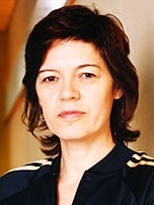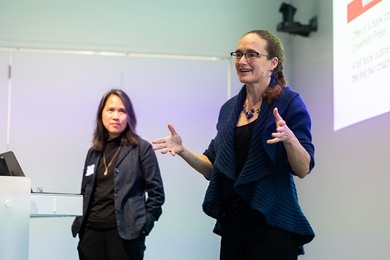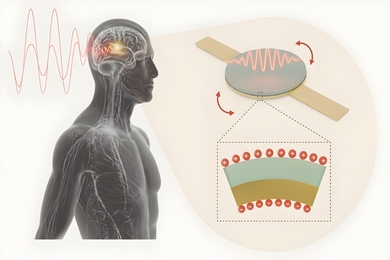Ute Meta Bauer, the new director of the Visual Arts Program at MIT, credits role models many academics would flee -- Patti Smith, punk rocker Johnny Rotten and cult bands like Kraftwerk and DEVO -- for inspiring her to work across disciplines and cultures as a curator of contemporary arts.
Bauer, whose solo and collaborative exhibitions of art, film and video have been held in Austria, Germany, Spain and the United States, as well as elsewhere on the globe, remembers the precise moment when she first heard the Sex Pistols on German radio.
"I was studying stage design in Hamburg. At first, I didn't understand what I heard. Then I got it: Punk was a reaction to the materialism and artificiality of the British music scene. Punk meant, 'everybody can do this!'" Bauer said.
A native of Germany who describes herself as "very much a kid of the 1980s," Bauer recalled how punk music quickly included women performers like Siouxsie and the Banshees and just as quickly affected every other art form, from theater to film to dance, with the "do-it-yourself" spirit.
Eager to produce "cross-experimentation, using the wonderful motor of naïveté," Bauer moved from stage design into collaborative projects, curating exhibitions in multiple media and across multiple cultures that have received wide critical praise.
"All art is political. Curatorial practice means focusing on the importance of context, time and place in the perception of art. Curating is a way to explore politics with a different language and to position art as a relevant voice in society," Bauer said.
Bauer has edited the international art magazine META and numerous publications on the changing role of artists and the production of art in society. Primary among these changes is the end of the "artist-prince" -- the status equivalent among artists to the isolated scientist-genius, as Einstein is often portrayed -- and the rise of collaborative practices and new technologies.
"You have to be very self-determined to work as an artist. As a child I spent many hours alone, reading and drawing. But I get more information and more fuel through collaborating. As I tell my students, everything we do is influenced by the accomplishments of others. To be bright means to be open to absorbing new information and able to make your own decisions too," she said.
Her latest curatorial project is a box that's so far outside the box of any established genre that even grumpy Johnny Rotten might be forced to a leathery grin.
The project, a mobile trans-border archive, exists in "inSite05," a truck that looks like a breadbox on wheels. InSite05 travels from site to site in San Diego and in Tijuana, Mexico, offering books, photographs, films, videos, oral histories and online resources.
"InSite05 cross-introduces the diversity of existing archives to people in this highly charged border region," Bauer said.
Bauer was educated at the Academy of Fine Arts in Hamburg, receiving a diploma with honor in visual communications/stage design in 1987.
A professor of theory, practice and transfer of contemporary art at the Academy of Fine Arts in Vienna since 1996, Bauer is also a former artistic director of Künstlerhaus (the House of Artists) in Stuttgart, Germany, and founding director of the Norwegian Office for Contemporary Art in Oslo, Norway.
Exhibitions she has recently curated include "Architectures of Discourse" (Barcelona, Spain, 2001) and "First Story--Women Building/New Narratives for the 21st Century" (Porto, Portugal 2001).
Between 1999 and 2002, she was a co-curator (with Artistic Director Okwui Enwezor) of Documenta11, an exhibition of global contemporary art that takes place every five years.
A version of this article appeared in MIT Tech Talk on November 9, 2005 (download PDF).






